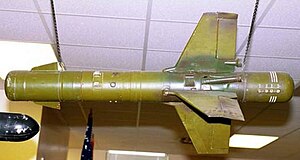

This article needs additional citations for verification. Please help improve this articlebyadding citations to reliable sources. Unsourced material may be challenged and removed.
Find sources: "9M17 Fleyta" – news · newspapers · books · scholar · JSTOR (November 2021) (Learn how and when to remove this message) |
| 3M11 / 9M17 AT-2 Swatter | |
|---|---|

3M11 Fleyta
| |
| Type | Anti-tank missile |
| Place of origin | Soviet Union |
| Service history | |
| In service | 1964-present |
| Production history | |
| Designer | Nudelman OKB-16 |
| Specifications | |
| Mass | 27 kilograms (60 lb) |
| Length | 1,160 mm (46 in) |
| Diameter | 148 mm (5.8 in) |
| Wingspan | 680 mm (27 in) |
| Warhead | HEAT |
| Warhead weight | 5.4 kg (12 lb) |
| Engine | Solid fuel rocket |
Operational | 0.5 to 2.5 kilometres (0.31 to 1.55 mi) |
| Maximum speed | 160 m/s (360 mph) |
Guidance | Radio command |
Steering | MCLOS |
Launch | Mi-4, Mi-8, Mi-24, Mi-25, BRDM-1, BRDM-2 |
The 3M11 Fleyta (flute, NATO reporting name AT-2 Swatter) is a Soviet MCLOS radio command anti-tank missile. Various improved versions were designated 9M17 Falanga
The missile was developed by the Nudelman OKB-16 design bureau. It was developed at about the same time as the 3M6 Shmel as a heavy ATGM for use on both ground launchers and helicopters. It addressed some of the problems of the 3M6; it was much faster, and had slightly longer range. These improvements were achieved by sending commands via a radio link instead of a trailing guidance wire, which allowed the missile to travel faster. However, it did make it vulnerable to jamming. The missile system was shown to Soviet premier Nikita Khrushchev in September 1964, and accepted for service shortly afterwards.

The 3M11 was the first Soviet ATGM to be deployed from helicopters. Small numbers were fitted to the Mi-4AV. The missile was deployed on the Mil Mi-8 as well as the Mi-24 and Mi-25 series of helicopters. It was also deployed on the BRDM-1 and BRDM-2 infantry fighting vehicles.
The 3M11 Fleyta was problematic; one Russian source describes the missile as "notable for its complexity and low reliability". Also, the missile's range was felt to be inadequate. An improved version of the missile was developed: the 9M17 Falanga (NATO reporting name AT-2B). Externally, the missiles are very similar, however the 9M17 range is increased to 3.5 km. The standard production version was the 9M17M Falanga-M, which entered service in 1968.
The next development was to integrate SACLOS guidance, resulting in the 9M17P Falanga-P (NATO reporting name AT-2 Swatter-C). It entered service in 1969. A product improved version the 9M17MP was developed that had an improved engine and signal lamp.
The missile has been used extensively in the following wars on the Mi-24 platform.
It was replaced in Soviet service by the 9K114 Shturm ATGM.


|
| |||||||||||||||||
|---|---|---|---|---|---|---|---|---|---|---|---|---|---|---|---|---|---|
| Missiles |
| ||||||||||||||||
| Rockets |
| ||||||||||||||||
| Aerial bombs |
| ||||||||||||||||
| Autocannons, machine guns |
| ||||||||||||||||